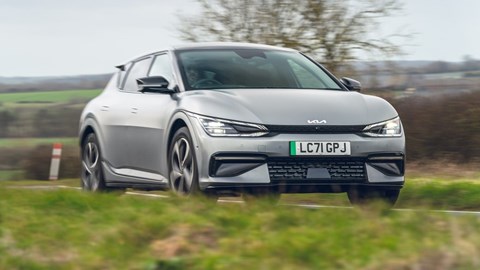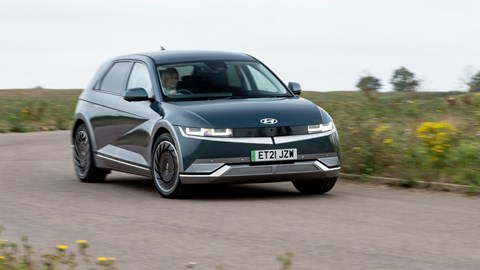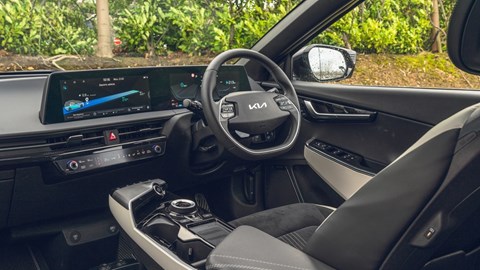► We test the first two E-GMP EVs
► The Kia EV6 is the premium choice
► But is it much better than the Hyundai?
The Hyundai Ioniq 5 and Kia EV6 look totally unique, but both share lots of technology underneath. Staggering R&D costs mean the EV industry is dominated by platforms – not marques – and it’s these white-label ‘skateboards’ that become the badged EV buyers will choose from. Pretty much every manufacturer has developed a platform to pin their grand EV plans on; from Volkswagen to Polestar – but Hyundai Motor Group’s E-GMP already looks like one of the best.
Featuring no ties to ICE at all, it’s a bespoke platform that can be stretched, shrunk and boosted to whatever Kia, Hyundai – and soon Genesis desires. According to the group’s head of R&D Albert Biermann, the platform will be the basis for at least 11 of 23 EVs on sale by 2025 – but it’s already spawned two impressive products: the Kia EV6 which is European Car of the year, and the sci-fi crossover that is the Hyundai Ioniq 5.
But which e-GMP SUV should you buy right now? We’ve driven both at length over a period of weeks to discover the key differences between the two. On this page we’ll compare the Hyundai Ioniq 5 to the Kia EV6.

Pre-flight briefing: Kia EV6
Why’s it here?
The Kia EV6 is one of our favourite EVs on the market – and it’s certainly our preferred electric crossover. Its combination of refinement and luxury – along with a poised chassis – has put it at the top of two CAR magazine group tests, and also won it the 2021 car of the year honours. The model we drove was a GT Line S 77.4kWh AWD, and cost £51,945.
Any clever stuff?
Aside from the design, the EV6 gets all the trinkets from the E-GMP platform, which means 24V charging, 350V fast-charging and a 300-mile range. Alongside the tech, the EV6 also makes use of the platform’s dual-motor capability; Kia engineers have stuffed an electric motor on each axle for a combined output of 321bhp.

Pre-flight briefing: Hyundai Ioniq 5
The Hyundai might not have the awards or the spotlight the Kia EV6 does but it’s an equally impressive car. It uses the same E-GMP platform as the Kia, retains the broad strokes of the interior and delivers a similar experience from £37,600. (Though we’re testing an Ultimate 73kWH AWD edition, which has the same dual-motor setup as the EV6)
Any clever stuff?
The Hyundai is pretty much the same as the Hyundai here. An E-GMP framework means 73kWh battery, 301bhp, 446lb ft of torque, fast-charging, 267 miles of range and the ability to also charge devices with an adaptor. Special mention should go to the Ioniq 5’s styling: it may look like a hatchback, but it’s crossover-sized. A bit like a Tardis, except it’s big on the inside and the outside too.
Our two contenders
The Hyundai Motor Group first unveiled the E-GMP platform in 2020, during the height of the Covid epidemic. Between the dodgy internet connection, pandemic uncertainty, and early start time, it was hard to visualise what the E-GMP could produce – no matter how good it appeared on paper. Fast-forward to 2022, and we’re looking at the most sophisticated iteration of it so far; the Kia EV6.
Pure science fiction on the outside, the Kia EV6 hides its size with design that’ll get a second look anywhere. From its rather aggressive stance and matte paint to its meat tenderiser indicators, (this does make sense if you’ve seen one in person) the EV6 is an incredible piece of design. And it continues inside, too.

Cars like the Kia EV6 and the VW ID.3 force you to recalibrate your brain, because the interior to exterior space simple doesn’t match up. There’s lots of room here; no transmission tunnel means there’s lots of space to your left or right, and no engine means the HVAC gubbins are pushed further forward than usual – giving you even more room.
Front and centre are a pair of 12.3-inch screens. They’re pretty much identical on both cars, and display a sharp, bright UI in high resolution. The cockpit screen uses clear, concise graphics to show your power output, regen rate, speed, cruise control and more – and you’ll also get a live feed from your blind spot when indicating. As you’d expect, both UIs also change slightly, depending on the driving mode you’re in.
The centre screen is loaded with the usual KIA and Hyundai user interface, although here it’ll occasionally display EV-only graphics and stats depending on the state of the car. While perfectly useful, I relied primarily on the brighter, easier UI of Apple CarPlay. Android Auto is available too, though.
Thankfully you don’t have to do everything via touch, as both Kia and Hyundai have decided to include physical buttons for things such as the A/C – or persistent switchable displays in the case of the Kia – so you’ll spend less time swiping and more timing changing the parameters you want.
Have a rummage around, though, and you’ll soon see where the Hyundai gives up the premium edge to the Kia. The latter’s persistent display (the bottom panel can be switched between media controls or A/C ones) is better than the Hyundai’s budget-looking digital read-out. Both work as expected, but the Hyundai solution feels less luxurious. The Kia also goes for leather, piano black and slightly more muted tones, all of which make it a more conventional luxury area than the Hyundai’s silver and neon.
Both offer reasonable space and leg room at the rear – at least from someone around 6’2 like me – though neither have the recessed footwells you’ll find in EVs such as the Porsche Taycan. That means your knees can be somewhat elevated, and that could get tedious over longer periods.
Plushness aside, both are kitted out with all the safety tech you’d expect; adaptive cruise, lane-keeping and cross-traffic warnings are all here.
The Hyundai looks cool
Step out of the Ioniq for a minute, and you’d be mistaken for thinking it’s the more premium car. Looks are subjective, but I find the Hyundai’s retro-modern style makes it even more eye-catching than the Kia. Clean, but etched with sharp lines it’s certainly bold – while its front and rear lights fuse the charm of the 80s with the tech of 2022.
The Ioniq 5 certainly looks like the faster of the two, and its styling really deserves the hotter N package Hyundai is currently testing. What’s more, early concepts of the Ioniq 6 suggest Hyundai and Kia will have the same problem once again – as the second Ioniq EV looks arguably even better than this.
What are they like to drive?
The differences start before you even turn a wheel: the Hyundai’s gear selector is mounted to the right of the steering stalk, while the Kia uses a rotary control that floats where the transmission tunnel would be. Both get the job done, though I actually felt the Hyundai’s was a little more interesting.
Set off in either car and you immediately get that instant torque you’d expect from an electric car – but in both the Kia and the Hyundai especially it feels smoother and more dialled down. Don’t expect Tesla’s R/C car throttle response; the Hyundai’s dual motor powertrain is good enough for a 0-62mph of 5.2 – the same as the Kia.
In practice, the Hyundai is the looser of the two, something that helps around town. Despite its size, the Ioniq 5’s quick rack makes it easy to slot into spare bays at Morrisons – or slip into a multi storey. The Kia EV6 isn’t cumbersome by any means, but it’s less about ease and more about overall performance.
Of course, the Hyundai’s city-centric handling is more exposed in faster driving. Here, the Kia benefits from extreme poise for such a large car; acting more killer whale through quick bends, than…well, whale. Despite a touch more power, (321bhp to 301bhp) more progressive steering and a sportier chassis make the Kia feel far more composed than the Hyundai. It’s only in the braking zones that you become more aware of just how big it is.
Warp to the same road and time in the Ioniq 5, and you’ll find more roll, twitchier steering, and duller power delivery – highlighting the Hyundai’s slightly different skill set. It’s by no means as nervous as a Tesla Model Y – which handles a bit like a shopping trolley on five Red Bulls – but it’s less assured than the EV6.
Price and verdict
The Hyundai Motor Group has taken its E-GMP platform and formed it for a two-pronged attack on two similar but different segments of the EV market. The result is a duo that share a lot but diverge in key areas to appeal to different buyers.
The EV6 is the superior car, but we can’t help but feel the Hyundai’s overall package isn’t too far behind – especially with its cheaper retail price: interior trim aside it’s just 33 miles of range and 20bhp short of the EV6.
The Kia has all the hallmarks of a premium car; it’s stylish, poised, and comfortable – and just happens to be electric. The Hyundai replaces premium with fun and offers practicality, style and well… more style.
Personally, I’d appreciate the Kia EV6 from the interior of my ‘very-nearly as good’ Ioniq 5. I’d make do with less performance and range and less premium for the improved styling. But I’d also be first on the list for the forthcoming Ioniq 5 N.